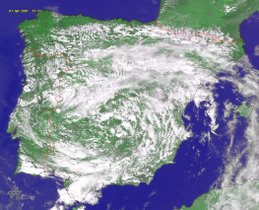E AS RELAÇÕES COM O SISTEMA OCEANO-ATMOSFERA NA REGIÃO DO ATLÂNTICO NORTE
Resumo
A variabilidade da precipitação em Portugal, no período 1900-1993, é estudada a partir de um índice pluviométrico, mensal e estacional (NOV-MAR) que foi construído utilizando uma Análise em Componentes Principais (ACP). Esse índice é constituído pela série temporal do 1º factor que ultrapassa sempre os 60% de explicação da variância total. Procuraram-se relações entre a variabilidade pluviométrica em Portugal Continental e o comportamento do sistema oceano-atmosfera no Atlântico Norte. Para o efeito escolheram-se dois parâmetros para serem confrontados com o índice pluviométrico: a temperatura da superfície do oceano (TSO) e o campo do geopotencial a 850hPa na artmosfera do Atlântico Norte. A análise dos ciclos revelou uma variabilidade da precipitação que poderá estar ligada com a TSO. Ciclos muito significativos de 3,4 e 7/8 anos foram detectados quer na TSO, quer no índice pluviométrico. Foi elaborado um mapa de correlação entre o índice pluviométrico e o campo da TSO e, também, uma análise compósita da TSO para testar a diferença entre os anos mais chuvosos e mais secos. Os padrões resultantes nos dois casos denotam não só uma estreita relação entre a variabilidade da TSO e a variabilidade da precipitação, mas também a existência de uma repartição diferente da TSO para anos chuvosos e anos secos. A correlação entre o índice pluviométrico e o campo do geopotencial a 850hPa faz realçar o modo típico da Oscilação do Atlântico Norte (OAN). As correlações entre o índice pluviométrico e os índices da OAN à escala mensal, revelam que é no período entre Dezembro e Março que a influência da OAN é mais elevada e sgnificativa.
Palavras Chave: Variabilidade da precipitação, Índice pluviométrico, Sistema Oceano-Atmosfera, Estação chuvosa.




Abstract
The scope of this study is to analize rainfall variability in the portuguese rainy season (Nov-Mar) during the 20th century, and examine some relations with the sea surface temperatures (SST) and geopotential heights at 850hPa (Z850) in the North Atlantic region. To build the portuguese rainfall index (PRI), a principal component analisys (PCA) was performed on a matrix containing seven portuguese stations with secular records (variables) and the years 1900 to 1993 (observations). This index is the first principal component (PC), which explains always more than 60% of the total variance and all the seven stations used in the PCA have positive correlations with the first component. Therefore we can assume that the first PC describes the rainfall variability in Portugal and the PCA has detected only one coherent area in portuguese territory. The analysis of cycles reveals a variability that might be linked with the North Atlantic ocean-atmosphere system. Very significant cycles of 3,4 or 7/8 years were found either in the PRI or in the first PC of SST time-series. In order to search the causes of the rainfall variability in Portugal, several correlations and composites analysis were made. Correlations between the PRI and the North-Atlantic Oscillation (NAO) index are always negative for all rainy season months (Nov-Mar). The correlation between the PRI and the SST in North Atlantic shows a central area with significant negative coefficients (west of portuguese coastline). Positive correlations above 50°N and below 30°N. The correlation between the PRI and Z850 field shows a North-Atlantic Oscillation (NAO) pattern: positive correlations in the North and negative correlations in the south of North Atlantic Region. In addition a composite analysis was made for wet and dry years to test the reaction of the SST field. There was found a distinct pattern in the SST field for wet an dry years.
Key words: Rainfall variability, Portuguese rainfall index, Ocean-Atmosphere System, Rainy season


No comments:
Post a Comment